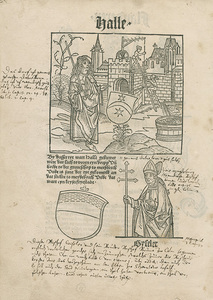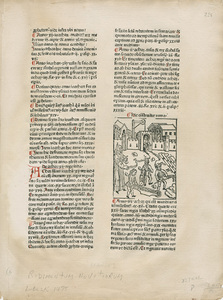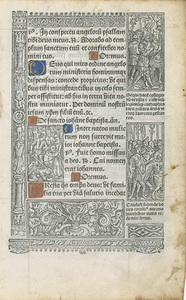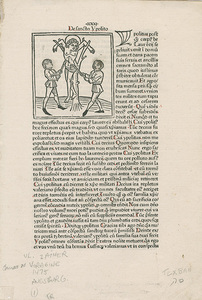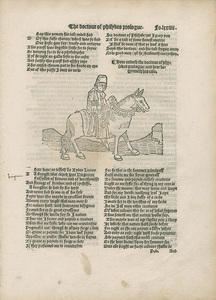Medieval Incunabula
These leaves from Medieval books show how Medieval book design and styles from the early years of printing influenced the later fine printing presses of the Arts and Crafts Movement. Three of these leaves are from 15th century German preses that had a profound influence on William Morris.
This leaf from the Chronicle of Saxony includes a page titled Halle with detailed woodcut illustrations and gothic script text. This particular leaf is heavily annotated with notes on the figures depicted. In this exhibit, Some German Woodcuts of the Fifteenth Century is opened to the replicated example of this text from Morris’s own library.
Leaf with red initials, paragraph markings, and a woodcut illustration. William Morris had a notable interest in fifteenth century German woodcuts such as this. This woodcut is similar to those found in the Ashendene Press publications of Dante Alighieri’s Divine Comedy. This style of dynamic red initials continue in all of the fine presses of the Triple Crown and Eric Gill Collections.
This leaf from a book of hours, believed to have been printed in Paris, provides an excellent example of smaller woodcut illustrations that contain incredible detail, such as seen in William Morris’s designs 500 years later. In addition this leaf includes hand painted red, blue, and gold inked initials reminiscent of the coloring patterns and design of the later Ashendene, Doves, and Golden Cockerel Presses.
Leaf shows initial ornamental “Y” initial, woodcut illustration, and red markings within the text for punctuation and capital letters. This leaf comes from the same 1475 edition of the Legenda Aurea that William Morris owned and was included in the Kelmscott Press’s 1898 publication, Some German Woodcuts of the Fifteenth Century.
Equestrian woodcut leaf inset depicts the Physician from The Canterbury Tales with his own prologue and tale. The design of the woodcut, font, and page shows the influence such early book design styles had on William Morris and his own edition of The Works of Geoffrey Chaucer.
